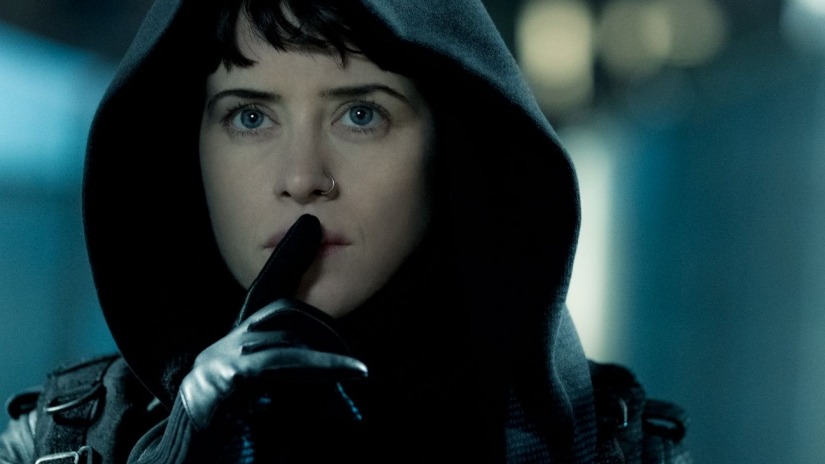Lisbeth Salander stands before a winged statue, leather clad, her face smeared with white paint, her expression determined and resolute. She’s the winged assassin who fights for what’s right. As her sister Camilla (Sylvia Hoeks) later describes her, she’s the woman who hurts men who hurt women. The Girl In The Spider’s Web has a powerful opening scene. Similar to the unforgettable tattooing scene in David Fincher’s The Girl With The Dragon Tattoo, in which Rooney Mara’s Salander takes justice into her own hands for the man who assaulted her, here Claire Foy’s Salander literally strings up a corrupt and abusive businessman before seizing his financial assets and physically and financially freeing his bloodied wife. Unfortunately, this is the only scene in which Salander hurts a man who hurts a woman. It’s also the best scene of the film.
It’s been seven years since we last saw Lisbeth Salander in an English language adaptation of Stieg Larsson’s Millenium trilogy. Jumping ahead from the story of Larsson’s first book, director Fede Álvarez has chosen to adapt the fourth book in the series written by David Lagercrantz. The problem is that we’re not in Stockholm anymore, Toto. We’re sort of everywhere in a sprawling plot that verges on the ludicrous in which Salander suddenly finds herself in possession of a programme that controls the world’s nuclear weapons. She needs to return the programme to its rightful owner (Stephen Merchant keeping his Bristol accent) and in the process finds herself mistakenly wanted for being a danger to, well, the world. In amongst it all, Salander is also confronted by her estranged sister for the first time since their childhood.
The result is a genre-confused Bond film-cum-superhero story with none of the glamour of the former or the humorous asides of the latter. It’s a film that takes itself incredibly seriously, which would be fine if it were in the vein of the David Fincher adaptation or the Swedish language trilogy. The Millenium trilogy was never meant to be glamorous or funny, but it was never about a girl who saves the world either. The appeal of Fincher’s film was its brooding intrigue. In the typically desolate Scandinavian noir setting of an isolated island off Stockholm, Salander solves the case of a missing girl, alongside journalist Mikael Blomkvist, while coming to terms with her own trauma. Her troubled childhood was largely kept from the audience. We didn’t really know who she was, but we were drawn to her nonetheless.
The Girl In The Spider’s Web swiftly quashes all nuance and depth to Lisbeth’s character. Her past, so sparingly shared in the other adaptations, is spelled out in its entirety, with some traumatic visuals actually managing to lessen the impression of her dark past. Knowing everything that’s happened to Lisbeth Salander doesn’t help us. We never really wanted to know. What we loved were all the murky spaces that we never really understood, and we certainly never wanted the story of her past played out before us like a fairy tale, with such polarised good and evil characters and endless shots of spiders culminating in a major character humming ‘Incy Wincy Spider’ at the film’s climax. (No, I’m not joking).
It feels as though this film belongs to an entirely different franchise, not least because the character of Mikael Blomkvist, played by Sverrir Gudnason, is almost obsolete in this film. Billed as the first Millenium trilogy film to be putting Salander front and centre, it just feels as though Fede Álvarez needed an established character to fill the role of ‘person Salander will save because she’s good’. Gone is the relationship that the pair were exploring in the first film, Blomkvist is now a sitting duck in this motorbike-riding, sports-car-driving, huge-explosion-dodging cacophonous display of badassery.
Claire Foy, to her credit, is by far the best thing about this film. Her dedication to Salander’s emotional journey helps to somewhat ground a story that’s itching to fly off. It’s still a wildly far-fetched plot, but in the film’s quieter moments when we are treated to some close-ups on Lisbeth’s face, she manages to rein back the racing plot by conveying the emotional impact of seeing her long-lost sister and the unwanted memories that the reunion has stirred. In an early scene we see Salander settle herself in a circular window frame, the light rendering her a silhouette as she quietly smokes. She looks foetus-like. For a film that is trying to stress the impact of Salander’s childhood on her vigilante ways, it’s a moving visual from Fede Álvarez in a rare reflective moment that the rest of the film so sorely lacks.
The Girl In The Spider’s Web is in UK cinemas from Wednesday the 21st of November.

